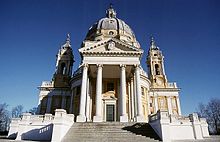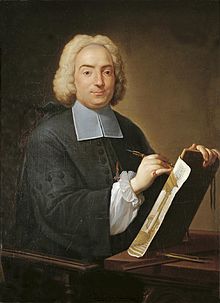Filippo Juvarra

Filippo Juvarra (born March 7, 1678 in Messina , † January 31, 1736 in Madrid ), also Filippo Juvara or Felipe Juvarra , was an Italian architect, set designer and engraver of the late Baroque period.
Life
Fillipo Juvarra came from a family of silversmiths in Messina. After he had already commissioned stage sets and festival decorations there, he went to Rome in 1706, where he won the competition for the new sacristy of St. Peter's Basilica , continued to deliver designs for the theater stage, but also devoted himself more to architecture and with Carlo Fontana learned.
In 1714 Viktor Amadeus II called him to Turin , where he became the most influential architect of his generation. His main works here are the basilica of Superga from 1716, the expansion of the Palazzo Madama from 1718 and the hunting lodge of Stupinigi from 1729. In 1735 Juvarra accepted the invitation of the Spanish King Philip V to Madrid, where he designed the new building of the Palacio Real and worked on other Bourbon building projects until his death , such as the Palacio Real in La Granja .
Juvarra was one of the greatest architects of the Baroque era , the number of his works is almost unmanageable: in his time in Turin he took on the construction management and revision of dozens of projects, he worked on churches , villas , city palazzi , castles and devoted himself to urban planning tasks. Juvarra's early works are based on models from the Roman Baroque, especially Francesco Borromini , who brought plasticity and movement into his designs. The last years of his life in Spain were still characterized by great creative urge. He acquired the ideas and suggestions for his building projects on several extensive trips to Europe, so that his work is also a synthesis of the European architecture of the 18th century.
Works (selection)
- 1708: The Capella Antamori in the Roman church of San Girolamo della Carità is Juvarra's only work in Rome outside of theater architecture.
- 1716–1731: On a hilltop visible from Turin, he built the Superga pilgrimage church , a central building with a flight of stairs and a monumental vestibule.
- 1715–1718: The facade of S. Cristina in Turin has a three-dimensional effect due to its concave protrusion, which is reminiscent of Borromini.
- 1732–1735: The Chiesa del Carmine in Turin is characterized by a new type of lighting from the high side windows between the wall pillars.
- In 1718 the Turin military district on the Pta. Susa built on his designs.
- 1718–1721 Juvarra put an atrium, a staircase and a new facade in front of the old Turin palace Palazzo Madama , with which he gave the medieval city castle a grandiose entrance with a theatrical gesture.
- 1730–1731 he designed the Stupinigi hunting lodge near Turin, with its original, elegant floor plan and the magnificent central ballroom.
literature
- Tommaso Manfredi: Juvarra, Filippo. In: Mario Caravale (ed.): Dizionario Biografico degli Italiani (DBI). Volume 62: Iacobiti-Labriola. Istituto della Enciclopedia Italiana, Rome 2004.
- Rolf Toman (ed.): The art of the baroque. Architecture, sculpture, painting. Könemann, Cologne 1997, ISBN 3-89508-991-5 .
Web links
| personal data | |
|---|---|
| SURNAME | Juvarra, Filippo |
| ALTERNATIVE NAMES | Juvara, Filippo; Juvarra, Felipe |
| BRIEF DESCRIPTION | Italian architect |
| DATE OF BIRTH | March 7, 1678 |
| PLACE OF BIRTH | Messina |
| DATE OF DEATH | January 31, 1736 |
| Place of death | Madrid |
